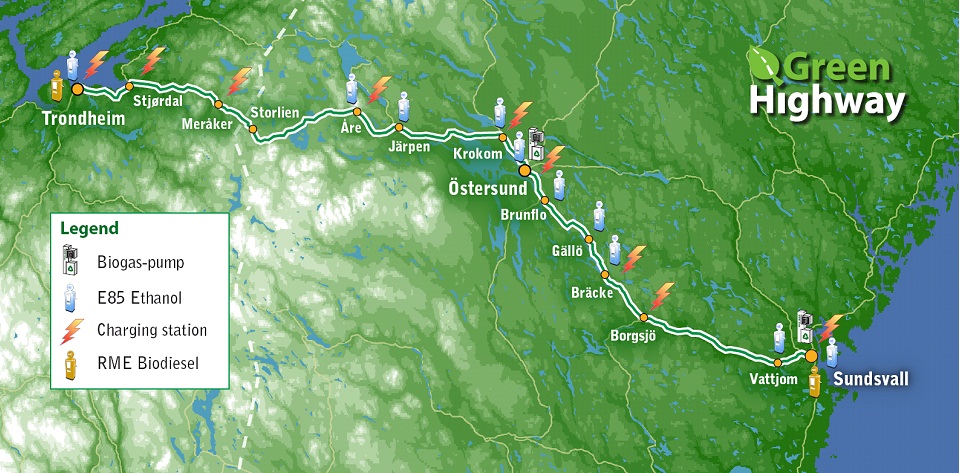Green Highway is a 450 km long stretch of road that promotes fossil-fuel-free transportation and aims to boost investment in green technology. It connects Östersund with Sundsvall (both in Sweden) and Trondheim (Norway) and consists of 222 electric vehicle charging points (13 rapid chargers and 209 standard chargers), stations selling renewable fuels (biogas, ethanol, and rapeseed diesel) and testing facilities for “green vehicles” (OECD 2012b; Tepecik Diş 2012).

One road, many partners
Green Highway was initiated as a means of meeting government targets for 150,000 electric cars in Sweden by 2020. It is a cross-border initiative driven by the municipalities of Östersund, Sundsvall, and Trondheim. Jämtkraft, Sundsvall Energy, and several other municipalities are also among the partners. Green Highway is part of the EU Interreg Sweden–Norway programme and is supported by the Trans-European Transport Networks (TEN-T). Other funding comes from several sources, including Jämtkraft, Sundsvall Elnät, and Mittuniversitetet (SEK 16.6 million for charging infrastructure) (Svensk Energi 2013) and the Swedish Energy Agency (Energimyndigheten; SEK 7.4 million). The current phase of the project (2015–2018) focuses on the development of liquefied biogas (LBG), promoting electric transportation and hydrogen-fuel cells, and establishing a sustainable business hub.
The Green Route
Thanks to the Green Highway, Östersund became the testing ground for the “Green Route” (Grön Rutt in Swedish), an innovative project from Postnord that aims to contribute to a reduction in its carbon emissions of 40% by 2020. Project manager Per Lundqvist explains the concept to Green Highway Magazine: “It’s really ridiculously easy. By moving the letterboxes and rubbish bins to one side of the street, we could reduce the distance travelled by 30 per cent” (Thalen 2014). The trial was undertaken through a partnership between Postnord, Tidningstjänst, Grön Trafik, the municipal waste management services, and the Swedish Transport Administration – and it worked! There are now approximately 400 households in the Östersund area on the “Grön Rutt” and several other Swedish municipalities have adopted the concept.
Playing to regional strengths is a winning strategy
Perhaps the most interesting aspect of the Green Highway is the way that has turned a potential weakness into a regional strength. The places linked by the Green Highway are generally low-density, small- to medium-sized towns with long commuting distances between them. Rather than fight the naturally resultant car dependency, this project has embraced it, with incredible results. Other factors that have been integral to the success of the Green Highway include:
- a political climate in which carbon neutrality is a policy priority, both in the countries concerned, and in the EU as whole
- favourable conditions for renewable energy in the region
- strong cooperation between many partners from different spheres (e.g. public authorities, private enterprises, and high-tech companies)
- use of an action-oriented approach focused on achieving results along the way.
The success of the project is evident in the substantial increase in green vehicle use in both Östersund and Jämtland since the inception of the Green Highway (see figure: Number of electric cars and plug-in hybrid electric vehicles in Östersund municipality and Jämtland County).
Regional dimension
The Green Highway has further strengthened cross-border collaboration as well as creating strong links between the municipalities it connects. As demonstrated in the Postnord case study, the Green Highway has also made the region desirable as a testing ground for green transport initiatives. Other examples include green vehicle testing and electric taxis. Finally, the Green Highway has become a destination in itself, thus increasing the potential for green tourism in the region.
Learn more...